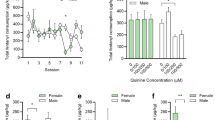Abstract
A model of drug discrimination based on a lithium chloride (LiCl) flavour aversion was described and examined. Mildly thirsty rats were presented daily with 4 ml of a distinctly flavoured solution which was followed on 50% of the days by an IP injection of LiCl. Prior to the flavour presentation, the rats were injection SC with saline or a training drug (0.04 mg/kg fentanyl or 20 mg/kg pentobarbital) to signal whether LiCl would follow. Almost all rats eventually exhibited stable behaviour that involved drinking most or all of the fluid when it was not to be followed by LiCl and little or no drinking when it was. Such discrimination occurred regardless of whether drug predicted LiCl (learned-discomfort) or predicted no LiCl (learned-safety). However, with fentanyl there were clear differences between rats trained with drug under learned-safety and under learned-discomfort conditions for 1) the rate of acquisition of stable performance as a function of LiCl dose, 2) generalization of the training dose to a test dose that was lower, and 3) elicitation of fentanyl responses by pentobarbital. These findings, together with indications that such effects did not always occur with pentobarbital as the training drug, were discussed from theoretical and practical perspectives.
Similar content being viewed by others
References
Braveman NS (1975) Formation of taste aversions in rats following prior exposure to sickness. Learn Motiv 6:512–534
Colpaert FC (1978) Theoretical review: discriminative stimulus properties of narcotic analgesic drugs. Pharmacol Biochem Behav 9:863–887
Colpaert FC (1982) The pharmacological specificity of operate drug discrimination. In: Colpaert FC, Slangen JL (eds) Drug discrimination: applications in CNS pharmacology. Elsevier Biomedical Press, Amsterdam, pp 3–16
Kautz M, Jeffreys R, McBride S, Pournaghash S, Schwartz M, Titley T, Wachsman A, Mastropaolo JP, Riley AL (1987) The sensitivity of conditioned taste aversions as a behavioral baseline to assess the discriminative stimulus properties of naloxone. Neurosci Abstr 13:1037
Lucki I (1988) Rapid discrimination of the stimulus properties of 5-hydroxytryptamine agonists using conditioned taste aversion. J Pharmacol Exp Ther 247:1120–1127
Martin GM, Gans M, van der Kooy D (1989) Discriminative properties of morphine that modulate associations between taste and lithium chloride (in press)
Mastropaolo JP, Moskowitz KH, Dacanay RJ, Riley AL (1986) Conditioned taste aversions in rats as a behavioral baseline for the assessment of the stimulus properties of phencyclidine. Neurosci Abstr 12:912
Mucha RF, Herz A (1985) Motivational properties of kappa and mu opioid receptor agonists studied with place and taste preference conditioning. Psychopharmacology 86:274–280
Mucha RF, Iversen SD (1984) Reinforcing properties of morphine and naloxone revealed by conditioned place preferences: a procedural examination. Psychopharmacology 82:241–247
Mucha RF, Iversen SD (1986) Increased food intake after opioid microinjections into nucleus accumbens and ventral tegmental area of rat. Brain Res 397:214–224
Nachman M (1970) Learned taste and temperature aversions due to lithium chloride sickness after temporal delays. J Comp Physiol Psychol 73:22–30
Overton DA (1977) Comparison of ethanol, pentobarbital and phenobarbital using drug versus drug discrimination training. Psychopharmacology 53:195–199
Overton DA (1982) Comparison of the degree of discriminability of various drugs using the T-maze drug discrimination paradigm. Psychopharmacology 76:385–395
Overton DA, Batta SK (1979) Investigation of narcotics and anti-tussives using drug discrimination techniques. J Pharmacol Exp Ther 211:401–408
Revusky S, Coombes S, Pohl RW (1982) Drug states as discriminative stimuli in a flavour-aversion learning experiment. J Comp Physiol Psychol 96:200–211
Riley AL, Jeffreys RJ, Pournaghash S, Titley TL, Kufera AM (1989) Conditioned taste aversions as a behavioral baseline for drug discrimination learning: an assessment with the dipsogenic compound pentobarbital (in press)
Richter JA, Holtman JR Jr (1982) Barbiturates: their in vivo effects and potential biochemical mechanisms. Prog Neurobiol 18:275–319
Sherman GT, Herz A (1982) Evidence that the discriminative stimulus properties of fentanyl and ethylketazocine are mediated by an interaction with different opiate receptors. J Pharmacol Exp Ther 221:735–739
Siegel S (1956) Nonparametric statistics for the behavioral sciences. McGraw-Hill, New York, USA
Stolerman IP, Shine PJ (1985) Trends in drug discrimination research analysed with cross-indexed bibliography, 1982–1983. Psychopharmacology 86:1–11
Author information
Authors and Affiliations
Rights and permissions
About this article
Cite this article
Jaeger, T.V., Mucha, R.F. A taste aversion model of drug discrimination learning: training drug and condition influence rate of learning, sensitivity and drug specificity. Psychopharmacology 100, 145–150 (1990). https://doi.org/10.1007/BF02244397
Received:
Revised:
Issue Date:
DOI: https://doi.org/10.1007/BF02244397



